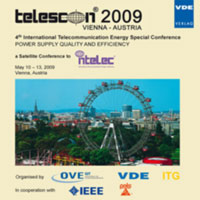The Next Generation Smart Telecom Power Distribution with Solid State Hypride Circuit Breakers and the Contribution to Power and Facility Management
Conference: telescon(R) 2009 - Power Supply Quality and Efficiency - 4th International Telecommunication - Energy special conference
05/10/2009 - 05/13/2009 at Vienna, Austria
Proceedings: telescon(R) 2009 - Power Supply Quality and Efficiency
Pages: 7Language: englishTyp: PDF
Personal VDE Members are entitled to a 10% discount on this title
Authors:
Mehl, Richard (E-T-A GmbH, Altdorf Germany)
Abstract:
While the speed of operation of conventional circuit breakers for equipment (CBE) is suitable for the majority of modern day equipment applications, ultra-sensitive solid-state circuitry of the nature typically found in telecom power distribution applications will often require faster switching protection under overcurrent conditions than electromechanical CBEs can achieve. Faced with this background this paper presents the case for solid-state electronic circuit breakers for smart telecom power distribution systems based on the concept of electronic interrupting devices. The functionality of electronic interrupting devices and their integrated serial communication bus link (enabling individual programming of the desired tripping thresholds for input under/over-voltage protection and output overload) is explained by examining integrated current limitation and protection characteristics for short circuit and overload sensing and in-built current flow interruption. The paper further illustrates the suitability of electronic interrupting devices for – 48VDC, -72VDC, as well as - 400VDC telecom power applications whereby particular emphasis is placed on an integrated remote monitoring capability via a serial bus. Power management aspects are also highlighted on the basis of a priority load shedding capability thereby ensuring battery buffer capacity is not wasted. This all leads into a matured and sophisticated power and facility management. Conventional electromechanical circuit breakers not only protect AC and DC circuitry from overload and short circuit conditions, but in parallel – importantly – additionally ensure that the required physical isolation criteria after contact separation are maintained. CBE manufacturers it is demonstrated therefore, need to be mindful, to incorporate such benefits of traditional electromechanical designs along with the enhanced solid state electronic switching requirements when considering their design options. For this reason, electronic circuit breakers are typically hybrid designs featuring an electrical contact in series with the semiconductor circuitry which remains open in the semiconductor „OFF “ state thereby ensuring the required isolation voltages can be withstood.


